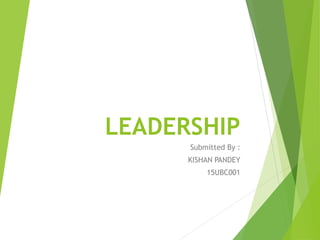
Leadership
- 1. LEADERSHIP Submitted By : KISHAN PANDEY 15UBC001
- 2. INTRODUCTION • Leadership is the ability to develop a vision that motivates others to move with a passion toward a common goal. So leadership is a process by which a person influences others to accomplish an objective and directs the organization in a way that makes it more cohesive and coherent.
- 3. DEFINITION • Leadership is the “process of social influence in which one person can enlist the aid and support of others in the accomplishment of a common task”. M Chemers. • "Leadership is ultimately about creating a way for people to contribute to making something extraordinary happen." Alan Keith.
- 4. FOUR FACTORS OF LEADERSHIP • Leader : • You must have an honest understanding of who you are, what you know and what you can do. To be successful you have to convince your followers not your superiors, that you are worthy of being followed. • Follower : • You must know your people. The fundamental starting point is having a good understanding of human nature, such as needs, emotions and motivation.
- 5. FOUR FACTORS OF LEADERSHIP • Communication : • The nonverbal communication is leading. E.g.- when you set example that communicates to your people that you would not ask them to perform anything that you would not be willing to do. Bad communication harm the relation between leader and employee. • Situation : • We must use our judgment to decide the best course of action and the leadership style needed for each situation. What we do in one situation will not always work in another.
- 6. Styles of Leadership The three major styles of leadership are Authoritarian or Autocratic : The authoritarian leader makes decisions alone as power is centralized in one person. Decisions are enforced using rewards and the fear of punishment. it is an abusive, unprofessional style called “bossing people around."
- 7. Styles of Leadership Participative or democratic : The participative leader include one or more employees in the decision making process. Communication flow freely; suggestions are made in both directions. The participation encourages member commitment to the final decision.
- 8. Styles of Leadership Delegative or Free Reign : The free-rein leader gives power to subordinates to make the decisions. However, the leader is still responsible for the decisions that are made. This is used when employees are able to analyse the situation. Delegative style is generally not useful.
- 9. THEORIES OF LEADERSHIP Theoriesofleadership TRAIT THEORY BEHAVIRAL THEORY CONTINGENCY THEORY
- 10. TRAIT THEORY • The Trait Approach arose from the “Great Man” theory as a way of identifying the key characteristics of successful leaders. It was believed that through this theory critical leadership traits could be isolated and that people with such traits could then be recruited, selected, and installed into leadership positions. This theory was common in the military and is still used as a set of criteria to select candidates for commissions.
- 11. BEHAVIOURAL THEORY • These theories of leadership are based upon the belief that great leaders are made, not born. • Rooted in behaviourism, this leadership theory focuses on the actions of leaders not on mental qualities or internal states. • According to this theory, people can learn to become leaders through teaching and observation. • The behaviour approach says that anyone who adopts the appropriate behaviour can be a good leader.
- 12. CONTINGENCY THEORY • In Contingency theory of leadership, the success of the leader is a function of various contingencies in the form of subordinate, task, and/or group variables. The Leaders who are very effective at one place and time may become unsuccessful either when transplanted to another situation or when the factors around them change. • This helps to explain how some leaders who seem for a while to have the 'Midas touch’ suddenly appear to go off the boil and make very unsuccessful decisions.
- 13. Leadership Qualities – Motivating capacity – Courage – Initiativeness – Source of Knowledge – Responsibility – Integrity – Ability to communicate – Loyalty – Judgement – Selflessness – Problem solving capacity – Openness to change – Distant vision and close focus – Balance
- 14. Ways to develop Leadership Qualities – Learn to think more critically – Do more to enthuse your team – Make your goals and future vision attractive and attainable – Learn to communicate clearly – Improve your speaking skills – Organize and allocate workflow – Make sure work is done correctly and on time – Find better ways to do things – Encourage progress and recognize efforts – Try to match individual skills and work – Build team spirit – Encourage people to work cooperatively – Recognize success and learn from failure – Trust your subordinates
